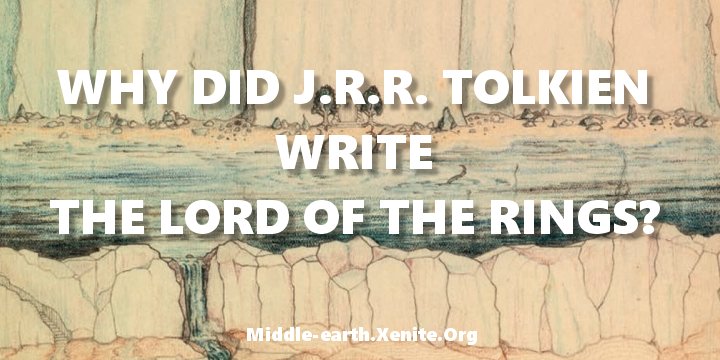
Q: Why Did Tolkien Write The Lord of the Rings?
ANSWER: As I pointed out in “Hobbit Tales, Or Never There And Back Again”:
The reason J.R.R. Tolkien wrote The Lord of the Rings was that his readers wanted to read more about hobbits. When first told this by his publishers, Tolkien replied, “I cannot think of anything more to say about hobbits. Mr. Baggins seems to have exhibited so fully both the Took and the Baggins side of their nature” (Tolkien, “The Letters of J.R.R. Tolkien”, p. 24).
In fact, Tolkien had a more fully formed thought than that he could not write more about hobbits:
All the same I am a little perturbed. I cannot think of anything more to say about HOBBITS. Mr Baggins seems to have exhibited so fully both the Took and the Baggins side of their nature. But I have only too much to say, and much already written, about the world into which the hobbit intruded….
That world was not the Middle-earth that we have come to know but it was an earlier Middle-earth that had begun to take shape only a few years before. Flush with the success of having published The Hobbit (which he never would have submitted to a publisher had it not been secretly shared with a family friend who had a connection in the publishing industry), Tolkien was beginning to dream the dream of publishing the Great English Novel. Novel is not quite the right word, though, for what Tolkien wanted to bring to print was The Silmarillion, which is anything but a novel.
The preamble to Letter 19 explains what happened:
[Tolkien lunched with Unwin in London on 15 November, and told him about a number of his writings which already existed in manuscript: the series of FATHER CHRISTMAS LETTERS, which he had addressed to his children each Christmas since 1920; various short tales and poems; and THE SILMARILLION. Following this meeting, he handed to Allen & Unwin the ‘Quenta Silmarillion’, a prose formulation of the latter book, together with the long unfinished poem ‘The Gest of Beren and Luthien’. These were shown to one of the firm’s outside readers, Edward Crankshaw, who reported unfavourably on the poem, but praised the prose narrative for its ‘brevity and dignity’, though he said he disliked its ‘eye-splitting Celtic names’. His report continued: ‘It has something of that mad, bright-eyed beauty that perplexes all Anglo-Saxons in the face of Celtic art.’ These comments were passed on to Tolkien.]
Tolkien wanted to resurrect a lost form of literature that has since been partially resurrected, partially re-evaluated, and partially transformed into a modern interpretation of Great Myths. 10 years ago I wrote in an essay (“Tolkien’s Time Machine: When Literary Worlds Collide”):
The Lord of the Rings may be Tolkien’s attempt define the modern English heroic romance as it might have evolved from an uninterrupted Anglo-Saxon literary tradition. Such a tradition could not have helped avoid importing influences from abroad. Anglo-Saxon authors would eventually have been introduced and reintroduced to the classics as the centuries unfolded. As Tolkien devised alternative plural forms for words such as “dwarf” (“dwarrows” and “dwarves” instead of the traditional “dwarfs”), so he may have sought to devise an alternative model for English literature. Eschewing the novel, he brought the heroic romance forward and gave it the framework that a rich literary tradition would have to provide. He could pick and choose from the best traditions that western literature has to offer. Why not? Anglo-Saxon authors throughout the past 1,000 years would not have ignored so many important steps in the evolution. Especially not when England became the dominant power in the world, and the English provoked their thought with ideas from around the globe.
Just as The Lord of the Rings is set in an imaginary time in our past, so it purports to be a translation of an ancient work, The Red Book of Westmarch. In fact, it may be a fictitious work on another level, an example of how the English might have carried forward their heroic traditions, and adopted models from other traditions, had there been no 1066 invasion….
Faced with a subsequent rejection of his Silmarillion mythology and a further request for more stories about hobbits, Tolkien set himself the task of writing about hobbits but he could not divorce himself from the desire to see the “greater story” find its way into print. That overwhelming desire was the passion that transformed Tolkien’s attempt to write what appears to have been a mediocre “story about hobbits” into The Lord of the Rings.
The story evolved because Tolkien could not resist the temptation to include more information about things that really weren’t connected with hobbits. In allowing himself to introduce each new aside, Tolkien stretched the fabric of the story further toward the world “into which the hobbit (had) intruded” and away from the “story about hobbits”.
The writing process naturally led Tolkien to add many new elements. He adopted ideas into Middle-earth that previously did not fit well with the Middle-earth that was centered around Beleriand. Hence, Tolkien was able to explore themes that eventually required the insight of a Tom Shippey or Christopher Tolkien to understand. J.R.R. Tollkien never foresaw any of these changes in the task he took up — he only thought, at first, that he was trying to please an inquisitive public that had asked for more about hobbits.
See Also:
Where Did J.R.R. Tolkien Get His Inspiration?
How Long Did It Take J.R.R. Tolkien to Write The Lord of the Rings
Why Did It Take So Long for The Lord of the Rings to be Published?
Why Did J.R.R. Tolkien Write The Hobbit?
# # #
Have you read our other Tolkien and Middle-earth Questions and Answers articles?

[…] Why Did Tolkien Write The Lord of the Rings? […]